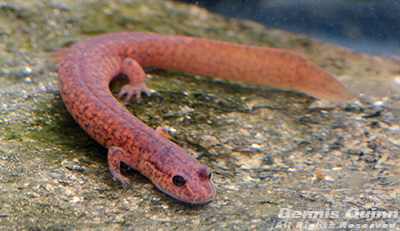Northern Spring Salamander
Gyrinophilus porphyriticus
State Threatened Species

Background and Range: The northern spring salamander is a brightly-colored member of the lungless salamander family (Plethodontidae). True to its name, it resides in cool water springs and streams, making it an excellent indicator of a clean, well-oxygenated water source.
Due to its strict habitat and clean water requirements, it is only found in a handful of locations within Connecticut. The Central Connecticut Lowlands divide this amphibian's range into distinct populations. Litchfield and Hartford Counties support the greatest populations of spring salamanders. This salamander is listed as a threatened species in Connecticut.
In North America, the spring salamander occurs from extreme southeastern Canada south through New England, west to Ohio, and south down the Appalachians as far as northern Georgia and Alabama.
Description: This large, robust salamander ranges in color from salmon to reddish-brown to purplish-brown, with a translucent white underbelly. The snout appears “square” when viewed from above and the salamander has well-defined grooves near its eyes to its snout. The tail is laterally flattened with a fin-like tip. Young spring salamanders are lighter in color and have small gills. Their coloration does not have deeper reddish tints until adulthood. Total length ranges from 5 to 7.5 inches.
Habitat and Diet: Spring salamanders require very clean, cool, and well-oxygenated water. They can be found in streams, brooks, and seepage areas. Preferred habitat lies within steep, rocky hemlock forests. This species is intolerant to disturbances.
Insects, worms, spiders, crustaceans, small invertebrates, and other salamanders make up the diet of spring salamanders.
Life History: These salamanders may remain active in springs and seepage areas year round. Breeding occurs in spring, and larvae can hatch from April through June. Larvae and young salamanders share the same habitats as adults. The larval stage is estimated to last 4 years, with sexual maturity occurring after 4 to 6 years.
Interesting Facts: Some spring salamanders can be cannibalistic, eating the young of their own species. Predators include northern watersnakes and gartersnakes.
Conservation Concerns: Conserving the spring salamander relies heavily upon protecting its habitat and preventing encroachment. Habitats that may seem “ideal” could lack populations entirely due to their sensitivity. Groundwater pollution from fertilizer runoff, pesticides, road salt, and industrial chemicals can degrade the preferred cool, clean water. Damming of streams can lead to increased water temperatures and reduced oxygen levels. Intensive logging removes the forest canopy, thus increasing water temperature. Construction, agriculture, and poorly performed clear-cutting are all activities that can degrade high quality streams, produce thermal pollution, and reduce oxygen in the water.
The spring salamander is protected by Connecticut's Threatened and Endangered Species Act. Collection of individuals is strictly prohibited.
What You Can Do
Awareness and education of this salamander's life history and habitats are invaluable tools for conservation. Consider the preservation of important spring and seepage habitat types. Not only are salamanders important, but their presence indicates a healthy wetland.
If you happen to find a spring salamander, admire it from a distance and then let it be. This species is sensitive to disturbances. If you lift any rocks while searching through springs and seepages, remember to place them back exactly how they were. Salamanders should never be collected from the wild. Report any observations of spring salamanders to the DEEP Wildlife Division at 860-424-3011 or deep.ctwildlife@ct.gov.
Avoid the use of fertilizers, herbicides, and insecticides in your yard. If you need to use these products, purchase ones that are natural and organic.
Additional information about salamanders is available on the Salamanders of Connecticut webpage.
Content last updated on October 11, 2016.

